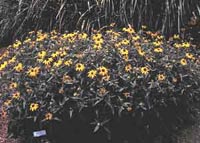Resource Library
Plant of the Week: Goldstrum Black-Eyed Susan
The University of Arkansas System Division of Agriculture does not promote, support or recommend plants featured in "Plant of the Week." Please consult your local Extension office for plants suitable for your region.
Plant of the Week
Goldstrum Black-Eyed Susan
Latin: Rudbeckia fulgida 'Goldstrum'

A student once stumbled across a quote in an English gardening book I wish I had kept. It went something like: "Anyone who grows members of the daisy family can hardly consider themselves a true gardener."
This smugness not only reflects extreme phyto-snobbery, it reveals an insular view of the world. In a maritime climate such as England, with its moderate temperature and gentle rainfall, it doesn’t take too much talent to get plants to thrive. But in the extremes we have to deal with here in Arkansas, you need tough plants. One of the toughest is Goldstrum black-eyed Susan.
Goldstrum is a 2-foot tall perennial that’s covered during much of the summer with a crown of golden yellow flowers with their typical brown center. The flowers are 3-inches across. The the hat-shaped central eye is a little less than an inch wide.
The Goldstrum’s foliage is basal in the spring, but as the stems begin to elongate, their leaves become smaller. The leaves of this species are dark green and free of hairs.
Rudbeckia fulgida is not the common black-eyed Susan we see blooming in midsummer throughout the state. That species is R. hirta, which is an annual or biennial that grows to 3-feet tall with scratchy pubescence on the leaves. Between the two species, R. fulgida and selections like Golstrum are much superior to the floppy, powdery mildew-ridden R. hirta.
This group of plants was named by Linnaeus, the famous Swedish botanist who developed the Latin naming system we use for plants. Linnaeus’ first real paying job in academia was in 1730 when Olaf Rudbeck the younger (1660-1740) hired the young second-year student to lecture in botany. Olaf’s father was the first instructor of botany at Uppsala and founded the world famous botanical garden at the beginning of the 18th Century.
On July 29, 1731, Linnaeus wrote Rudbeck and informed him that he was naming an American plant in his honor. According to Linnaeus, "So long as the earth shall survive, each spring shall see it covered with flowers, the Rudbeckia will preserve your glorious name." Today we call that sucking up to the boss, but in the 18th Century, before the days of public supported higher education, scholars had to find a patron to support them as they did their work.
The selection of Goldstrum as a garden plant fell to the Europeans, like so many other native American plants. The plant was first selected by Heinrich Hagemann in the Czech Republic in 1937, but it was not introduced until 1949 after the dust had settled from WWII, and then it was the world famous nursery of Karl Foerster at Potsdam, Germany that made the introduction. The plant belatedly received the designation as Perennial Plant of the Year in 1999 from the Perennial Plant Association.
Goldstrum rudbeckia is an easy to grow, long-lived perennial. It should be given full sun in a well drained, reasonably fertile soil. Because it’s such a vigorous grower, it should be placed at least 2 feet from its nearest neighbor.
An overly rich site may cause it to grow too tall and split open in the center as the crown of flowers appear. This can be guarded against by placing a supporting gridwork of branches over the top of the plant as it begins growing in the spring. About every third year, the clump should be dug, divided and then reset in the garden.
By: Gerald Klingaman, retired
Extension Horticulturist - Ornamentals
Extension News - August 10, 2001
The University of Arkansas System Division of Agriculture does not maintain lists of retail outlets where these plants can be purchased. Please check your local nursery or other retail outlets to ask about the availability of these plants for your growing area.